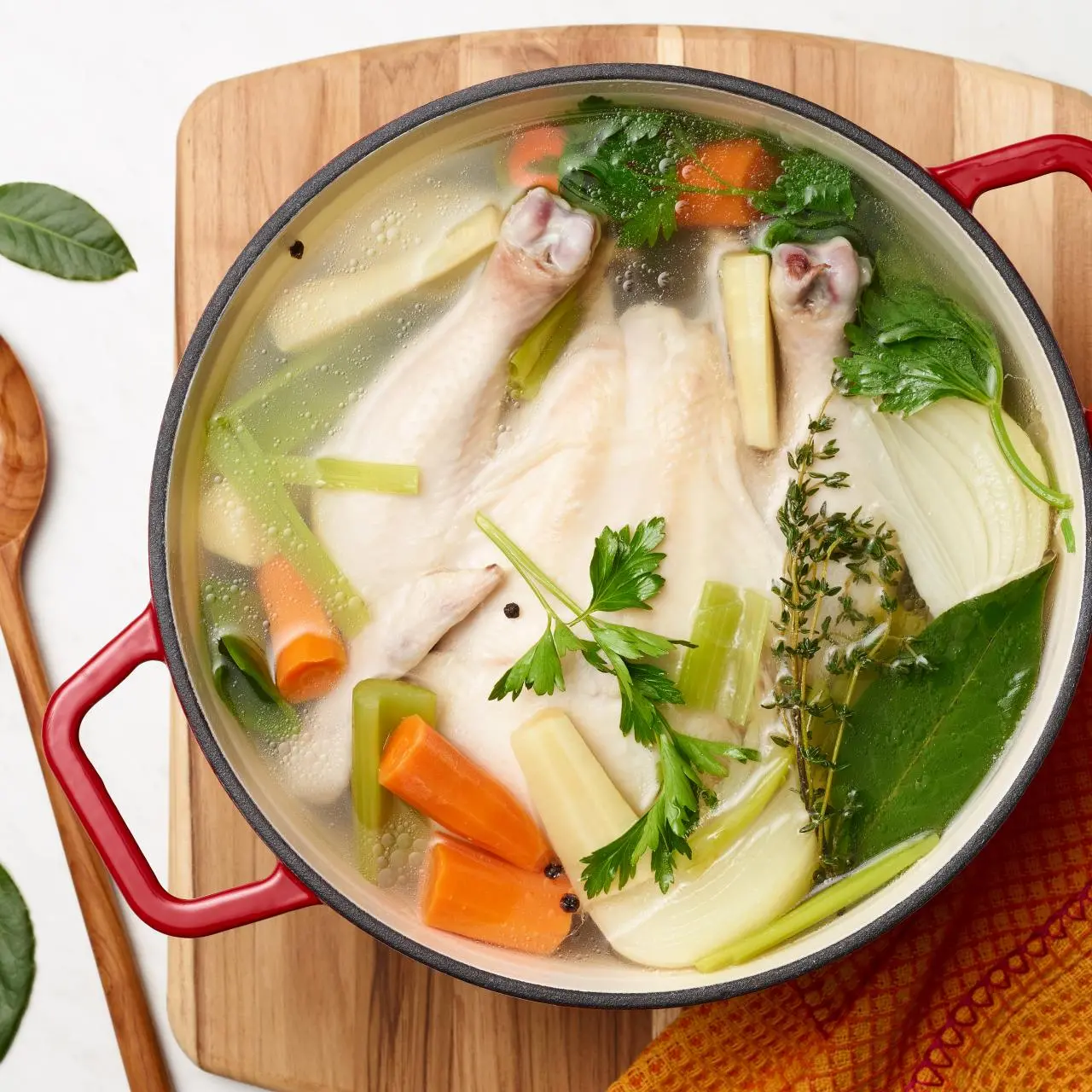The Benefits Of Bone Broth: What Every Health Enthusiast Should Know
The Benefits Of Bone Broth: What Every Health Enthusiast Should Know
Blog Article
The Ultimate Overview to Making and Appreciating Organic Bone Broths at Home
Bone broth has actually gained attention for its countless health and wellness advantages and culinary adaptability. Crafting organic bone broth in the house enables people to control the top quality of ingredients, guaranteeing a healthy end result. Understanding the selection of bones, vital flavor elements, and correct food preparation strategies is essential. As the process unfolds, one may wonder just how to raise their broth past the basics and incorporate it into daily meals for boosted taste and nourishment.
Recognizing the Health Advantages of Bone Brew
Although bone brew has actually been a staple in different foods for centuries, its wellness benefits have actually obtained significant focus over the last few years. Rich in collagen, amino acids, and minerals, bone broth is often proclaimed for its potential to sustain joint health and wellness, enhance digestive tract feature, and enhance skin elasticity. The jelly derived from prepared bones might help digestion and help secure the intestine cellular lining, possibly relieving problems like dripping intestine syndrome.Furthermore, the presence of nutrients such as glucosamine and chondroitin may contribute to lowered swelling and discomfort relief in joints. Additionally, bone broth is moisturizing and can function as a nutritious base for soups and stews. Several supporters also declare that it improves the immune system, thanks to its mineral profile. On the whole, the rebirth of rate of interest in bone broth is linked to its perceived capacity to promote general health and assistance various physical features.
Selecting the Right Bones for Optimum Flavor and Nourishment
What factors should one take into consideration when picking bones for broth prep work? The kind of bones used considerably impacts both taste and nutritional value. Initially, it is important to choose bones that consist of a mix of marrow bones, joint bones, and weighty bones. Marrow bones supply abundant flavors and healthy and balanced fats, while joint bones contribute collagen, improving the broth's dietary profile.Additionally, sourcing bones from grass-fed or pasture-raised pets warranties higher quality and more nutrients, as these pets are typically healthier. The freshness of the bones is also vital; selecting bones from regional butchers or farmers' markets can ensure excellent taste. Bone size matters also; larger bones launch more jelly, leading to a richer broth. Thinking about the kind of pet-- fish, beef, or chicken-- can affect the final taste, enabling for versatile brew choices customized to private choices.
Necessary Active Ingredients for a Delicious Bone Broth

Quality Bone Option
The structure of a tasty bone broth hinges on the cautious selection of high-grade bones. Sourcing natural, pasture-raised or grass-fed bones is necessary, as these choices are most likely to be without dangerous ingredients and provide premium nutrients. Ranges such as beef, poultry, or lamb bones each pass on distinctive tastes and wellness benefits. Bone types, including marrow bones, knuckle bones, and oxtails, contribute jelly and collagen, improving the brew's texture. Selecting bones with a mix of meat and connective tissue can also add richness and deepness. In addition, picking bones with visible marrow ensures a nutrient-dense brew, elevating the total top quality. Ultimately, investing time in high quality bone option lays the groundwork for a delicious and nourishing broth.
Aromatic Taste Boosters
Selecting high-quality bones establishes the phase for a healthy and abundant bone brew, yet it is the addition of aromatic flavor enhancers that genuinely boosts the dish. Active ingredients such as onions, garlic, and carrots not only present sweet taste yet additionally contribute deepness to the broth. Fresh herbs like bay, parsley, and thyme leaves add a fragrant note, while flavors such as black peppercorns and cloves present heat and intricacy. Additionally, incorporating a splash of apple cider vinegar can aid essence minerals from the bones, improving the brew. These taste enhancers develop an unified mix, changing a straightforward broth right into a savory foundation for sauces, soups, or stews, making it a flexible part in any cooking arsenal.
Step-by-Step Overview to Making Bone Broth in your home
Developing bone brew in the house can be a rewarding cooking venture that boosts both taste and nourishment in numerous meals. To start, one must pick top notch bones, preferably from grass-fed or organic resources. Toasting the bones at 400 ° F for regarding 30 mins can escalate the taste. Next off, transfer the roasted bones to a big pot or slow cooker and cover them with chilly water. Adding a sprinkle of vinegar helps extract minerals from the bones.Include fragrant veggies like onions, carrots, and celery for added depth, along with herbs and flavors as wanted. Bring the mixture to a boil, after that minimize to a simmer. It is vital to allow the broth simmer for a minimum of 12 hours, however longer is more suitable for optimum splendor. Strain the broth via a fine-mesh sieve and shop it in closed containers, prepared to boost meals with its nourishing significance.
Tips for Developing Your Bone Broth Simmer
While simmering bone brew, maintaining the ideal temperature level and timing is necessary for achieving a rich and flavorful result. A gentle simmer, preferably between 190 ° F and 210 ° F, assists essence maximum nutrients and flavors without steaming, which can make the brew cloudy. It is a good idea to monitor the pot very closely, adjusting the warm as necessary to maintain this simmer.Timing is likewise important; a longer simmer, usually varying from 12 to two days, permits much deeper flavor extraction and collagen release. For hen bones, a 12 to 24-hour simmer is sufficient, while beef bones gain from longer cooking times.Additionally, skimming any kind of foam or pollutants that rise to the surface area throughout the first few hours can enhance the broth's clearness and preference. Finally, guaranteeing the pot is covered during simmering aids to keep dampness and intensify the tastes, creating a much more rewarding output.
Creative Ways to Make Use Of Bone Broth in Your Food preparation
Integrating bone brew right into different dishes raises both taste and dietary value. Cooks and home cooks alike discover that making use of bone brew as a base for stews and soups boosts depth and richness, transforming easy recipes right into passionate meals. It can also be used in risottos, where Bone Broth Delivery the broth changes water, allowing the grains to absorb its tasty essence.Additionally, bone brew functions as an excellent food preparation liquid for grains like quinoa or rice, infusing them with nutrients and taste. For an included twist, it can be utilized in braising meats, causing tender, flavorful results. Also sauces take advantage of a splash of bone brew, enhancing their taste profile.Moreover, bone broth can be integrated right into smoothie mixes for an unforeseen wellness increase, offering healthy protein and nutrients without endangering taste. These imaginative applications display the flexibility of bone broth in day-to-day cooking, making it an important cooking area staple.
Storing and Maintaining Your Homemade Bone Brew
Proper storage and preservation of homemade bone brew is vital for keeping its taste and dietary advantages. Cold methods and refrigeration finest techniques play a crucial function in prolonging the broth's life span. Comprehending these methods can aid ensure that the broth stays secure and scrumptious for future use.

Freezing Techniques Discussed
Freezing methods are vital for successfully saving and protecting self-made bone brew, ensuring its abundant tastes and nutrients continue to be intact for future usage. To ice up bone brew, it is suggested to allow it amazing completely before moving it to storage containers. Glass jars, silicone mold and mildews, or sturdy fridge freezer bags appropriate options. When using containers, leave room on top for growth during freezing. Portioning the brew into smaller sized amounts enables very easy thawing and decreases waste. Label containers with the day and contents for very easy recognition. For peak quality, take in the frozen brew within 3 to six months - Beef Broth. Thawing can be done in the fridge or by utilizing a microwave, ensuring that the broth is warmed thoroughly prior to usage
Refrigeration Best Practices
While several concentrate on cold as a method of conservation, refrigeration additionally plays an essential duty in saving homemade bone broth successfully. Once cooled down, bone brew should be transferred to impermeable containers, guaranteeing minimal air exposure to avoid spoilage. It is recommended to refrigerate brew within two hours of cooking to preserve its quality. Normally, homemade bone brew can be kept in the fridge for approximately five days. Identifying containers with days can help track freshness. For peak flavor and safety and security, broth must be reheated to a moving boil prior to usage. If great site longer storage is required, freezing continues to be an excellent option, but appropriate refrigeration methods assure that bone brew continues to be nutritious and delicious for temporary usage.
Often Asked Questions
Can I Use Frozen Bones for Making Bone Brew?
The question of using frozen bones for bone brew develops frequently (Organic Bone Broths). Specialists concur that frozen bones can be made use of efficiently, but they need to be thawed go to this web-site before cooking to assure optimal flavor and nutrient removal
For How Long Can I Shop Homemade Bone Brew?
:max_bytes(150000):strip_icc()/26460-quick-and-easy-chicken-noodle-soup-allrecipes-1x1-1-b88125437574471db3e114c40bc6928e.jpg)
Is It Safe to Reheat Bone Broth Several Times?
Reheating bone broth multiple times can position safety and security worries - Bone Broth Delivery. Each reheating cycle increases the danger of bacterial growth. It is a good idea to reheat just when and keep any leftovers quickly to guarantee safety and quality
Can I Add Veggies to the Broth for Flavor?
Including veggies to broth enhances flavor and nutritional worth. Typical choices include carrots, onions, and celery. The vegetables instill their essence into the brew, producing a richer and a lot more full-flavored last item.
What's the Ideal Means to Thaw Icy Bone Brew?
To thaw frozen bone brew, one can put it in the refrigerator over night, make use of a microwave on low warmth, or immerse the secured container in warm water, making sure even thawing without compromising taste or nutrients. It is crucial to pick bones that consist of a mix of marrow bones, joint bones, and meaty bones. Marrow bones give rich flavors and healthy fats, while joint bones contribute collagen, enhancing the brew's nutritional profile.Additionally, sourcing bones from grass-fed or pasture-raised pets guarantees higher high quality and even more nutrients, as these animals are commonly much healthier. Bone kinds, consisting of marrow bones, knuckle bones, and oxtails, contribute gelatin and collagen, enhancing the broth's texture. Choosing top notch bones establishes the stage for a nutritious and rich bone broth, yet it is the addition of aromatic flavor boosters that genuinely raises the dish. Also sauces benefit from a sprinkle of bone broth, enhancing their taste profile.Moreover, bone broth can be integrated into healthy smoothies for an unanticipated wellness boost, supplying healthy protein and nutrients without jeopardizing taste.
Report this page